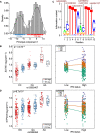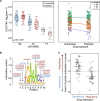Discovering in vivo cytokine-eQTL interactions from a lupus clinical trial
- PMID: 30340504
- PMCID: PMC6195724
- DOI: 10.1186/s13059-018-1560-8
Discovering in vivo cytokine-eQTL interactions from a lupus clinical trial
Abstract
Background: Cytokines are critical to human disease and are attractive therapeutic targets given their widespread influence on gene regulation and transcription. Defining the downstream regulatory mechanisms influenced by cytokines is central to defining drug and disease mechanisms. One promising strategy is to use interactions between expression quantitative trait loci (eQTLs) and cytokine levels to define target genes and mechanisms.
Results: In a clinical trial for anti-IL-6 in patients with systemic lupus erythematosus, we measure interferon (IFN) status, anti-IL-6 drug exposure, and whole blood genome-wide gene expression at three time points. We show that repeat transcriptomic measurements increases the number of cis eQTLs identified compared to using a single time point. We observe a statistically significant enrichment of in vivo eQTL interactions with IFN status and anti-IL-6 drug exposure and find many novel interactions that have not been previously described. Finally, we find transcription factor binding motifs interrupted by eQTL interaction SNPs, which point to key regulatory mediators of these environmental stimuli and therefore potential therapeutic targets for autoimmune diseases. In particular, genes with IFN interactions are enriched for ISRE binding site motifs, while those with anti-IL-6 interactions are enriched for IRF4 motifs.
Conclusions: This study highlights the potential to exploit clinical trial data to discover in vivo eQTL interactions with therapeutically relevant environmental variables.
Keywords: Clinical trials; Cytokines; Interactions; eQTL.
Conflict of interest statement
Ethics approval and consent to participate
The protocol (2014P002477) for analysis and data sharing was approved by the institutional review board of Brigham and Women’s Hospital subject to applicable laws and regulations and ethical principles consistent with the Declaration of Helsinki. The names of the ethics committees that approved the subject recruitment at each site are provided in Additional file 4: Table S7. All subjects gave written informed consent.
Competing interests
The authors declare that they have no competing interests.
Publisher’s Note
Springer Nature remains neutral with regard to jurisdictional claims in published maps and institutional affiliations.
Figures



References
Publication types
MeSH terms
Substances
Grants and funding
LinkOut - more resources
Full Text Sources
Medical
Molecular Biology Databases

